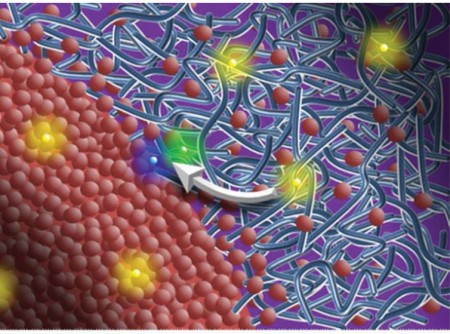Jan
11
Discovery of an Efficient Solar Cell
January 11, 2013 | Leave a Comment
Organic polymer-based photovoltaic cells are far less expensive to manufacture than silicon-based solar cells. Scientists have long believed that the key to high efficiencies rests in the purity of the polymer/organic cell’s two domains – acceptor and donor. Now an alternate and possibly easier route forward has been discovered.
Harald Ade, a physicist at North Carolina State University and longtime user of the ALS, who led this research explains, “We’ve shown that impure domains if made sufficiently small can also lead to improved performances in polymer-based organic photovoltaic cells. There seems to be a happy medium, a sweet-spot of sorts, between purity and domain size that should be much easier to achieve than ultra-high purity.”
Ade, the corresponding author with co-authors Brian Collins, Zhe Li, John Tumbleston, Eliot Gann and Christopher McNeill published their paper describing the work in Advanced Energy Materials titled “Absolute Measurement of Domain Composition and Nanoscale Size Distribution Explains Performance in PTB7:PC71 BM Solar Cells”.
Solar cell conversion efficiency in polymer/organic photovoltaic cells hinges on excitons – the electron/hole pairs energized by sunlight – getting to the interfaces of the donor and acceptor domains quickly so as to minimize energy lost as heat. Conventional wisdom has held that the greater the purity of the domains, the fewer the impedances and the faster the exciton journey.
The team became the first to simultaneously measure the domain size, composition and crystallinity of an organic solar cell. The accomplishment was made possible by three ALS beamlines, the #11.0.1.2, a Resonant Soft X-ray Scattering (R-SoXS) facility; #7.3.3, a Small- and Wide-Angle X-Ray Scattering (SAXS/WAXS/) end-station; and #5.3.2, an end-station for Scanning Transmission X-Ray Microscopy (STXM).
Collins, who is the first author on the Advanced Energy Materials paper notes the significance of the ALS in drilling to the understanding, “The combination of these three ALS beamlines enabled us to obtain comprehensive pictures of polymer-based organic photovoltaic film morphology from the nano- to the meso-scales. Until now, this information has been unattainable.”
The team used the trio of ALS beams to study the polymer/fullerence blend PTB7:PC71BM in thin films made from chlorobenzene solution with and without the addition (three-percent by volume) of the solvent diiodooctane. The films were composed of droplet-like dispersions in which the dominant acceptor domain size without the additive was about 177 nanometers. The addition of the solvent shrank the acceptor domain size down to about 34 nanometers while preserving the film’s composition and crystallinity.
This resulted in an efficiency gain of 42 percent.
Ade explains the significance of the research, “In showing for the first time just how pure and how large the acceptor domains in organic solar devices actually are, as well as what the interface with the donor domain looks like, we’ve demonstrated that the impact of solvents and additives on device performance can be dramatic and can be systematically studied. In the future, our technique should help advance the rational design of polymer-based organic photovoltaic films.”
42 percent is a huge improvement, and if the solution for manufacturers is an economical and easily adopted modification of processing the impact will be quite worthwhile.
Number crunchers like to point out that the amount of solar energy lighting up Earth’s land mass every year is nearly 3,000 times the total amount of annual human energy use.
Those kinds of illustrations point out why solar creates such enthusiasm. Paving the landmass of earth over with solar cells probably won’t work out, even 1/3000th of the landmass is a huge territory and that would still need multiplied by the efficiency factor. That makes the 42 percent gain very encouraging. But paired with big efficiency gains in electrical use, solar can get a market share worthy of more investment.
This kind of research is paving the way for a much more healthy solar panel business and more and much better options for consumers.


